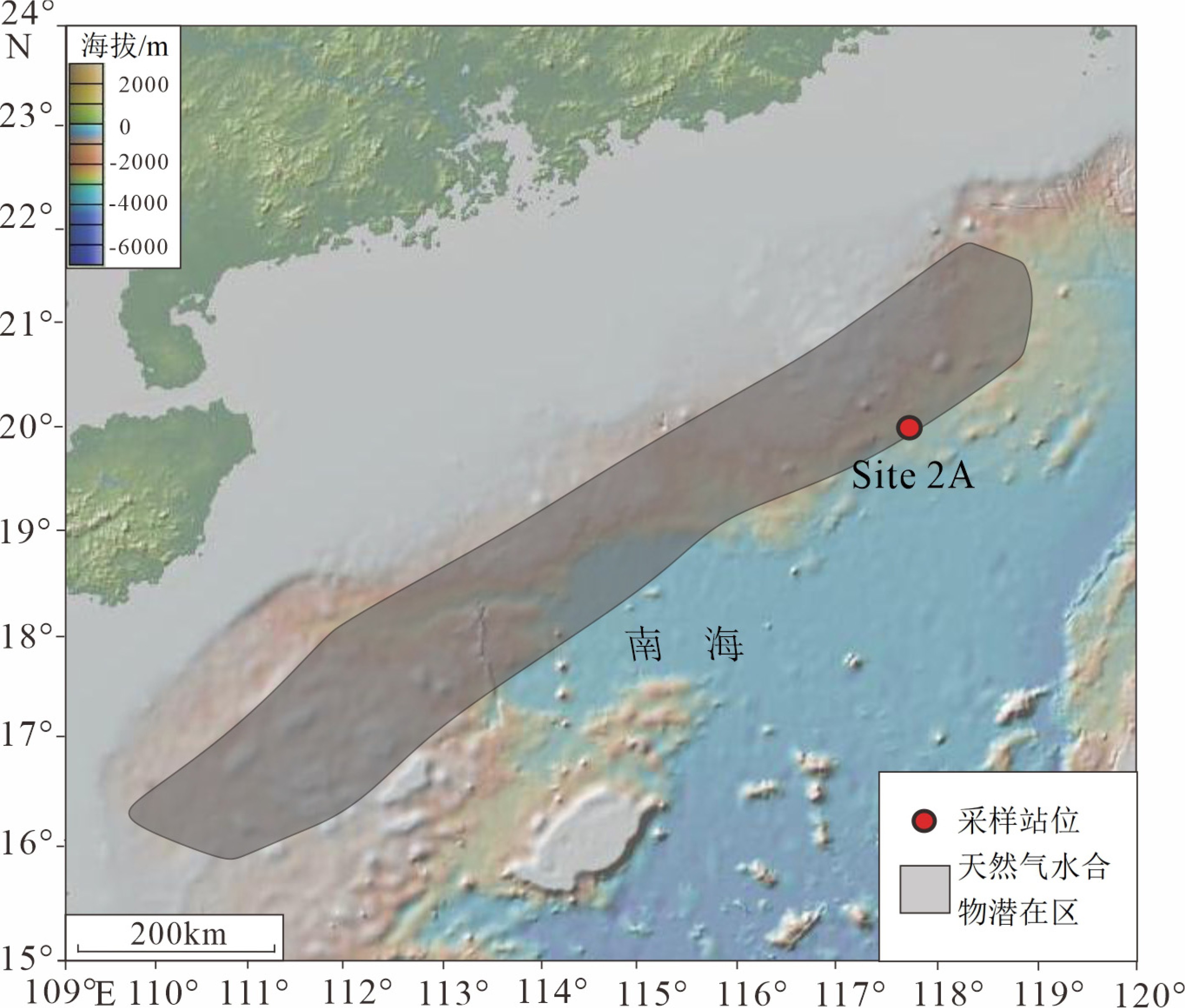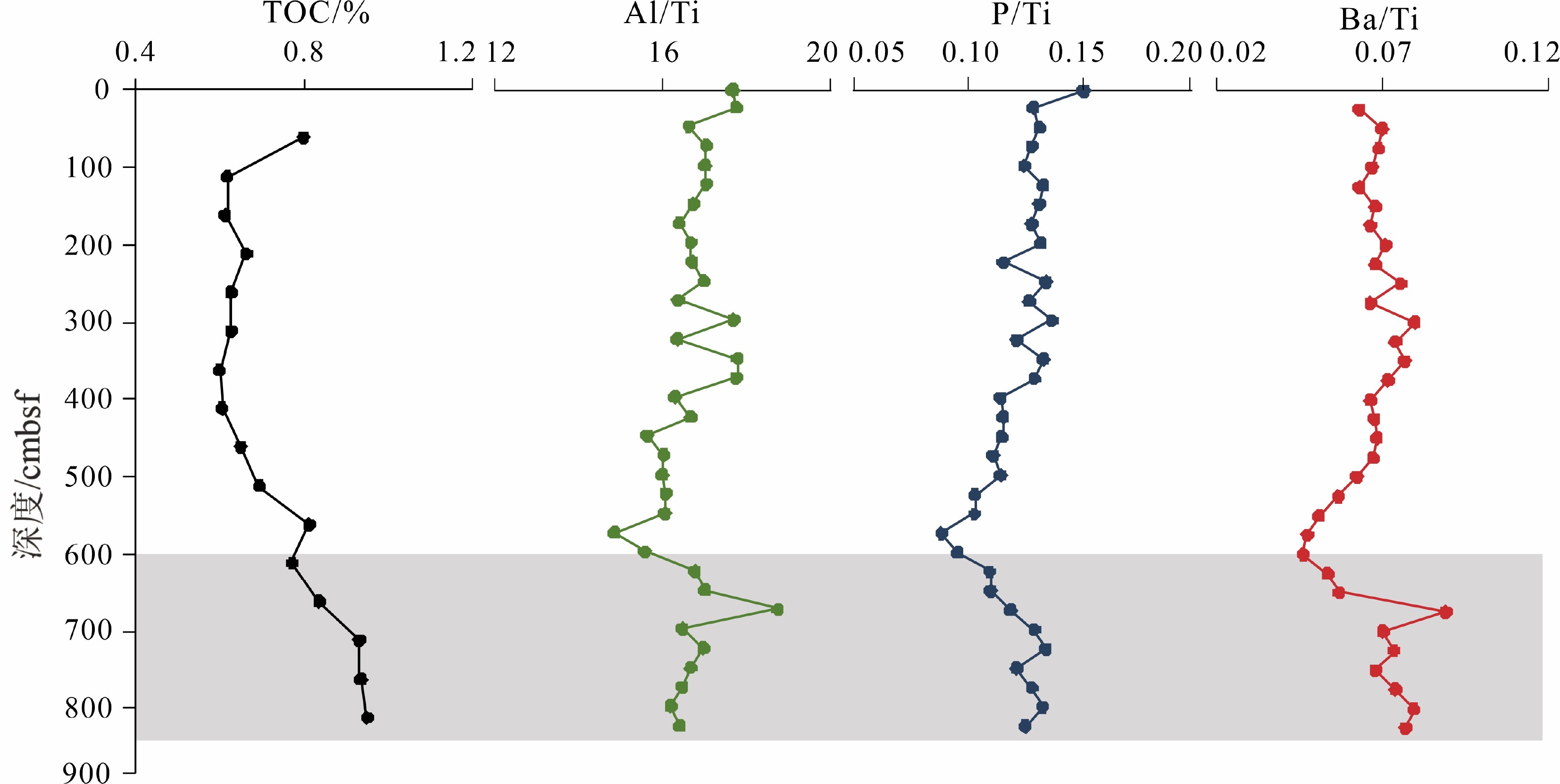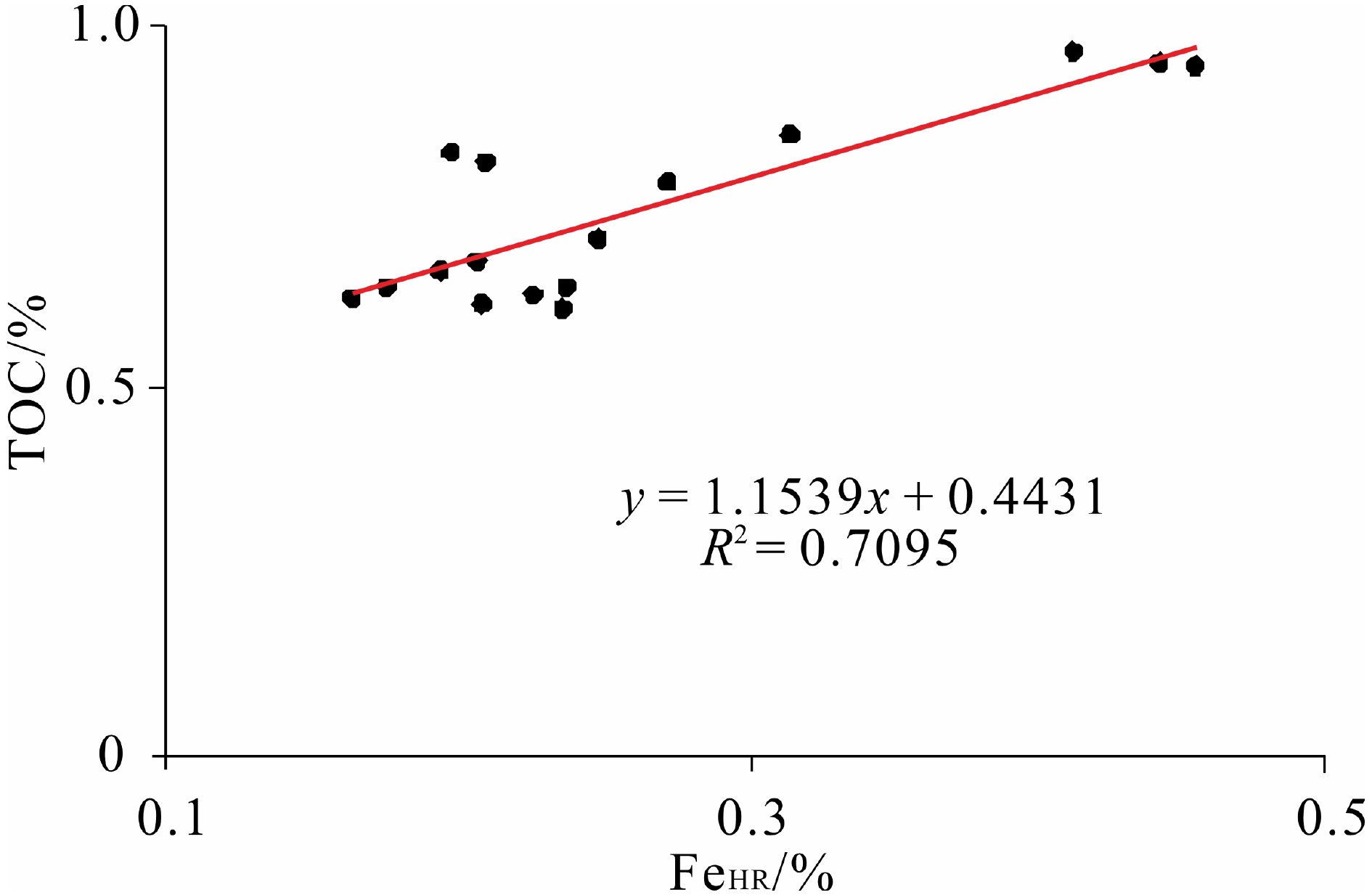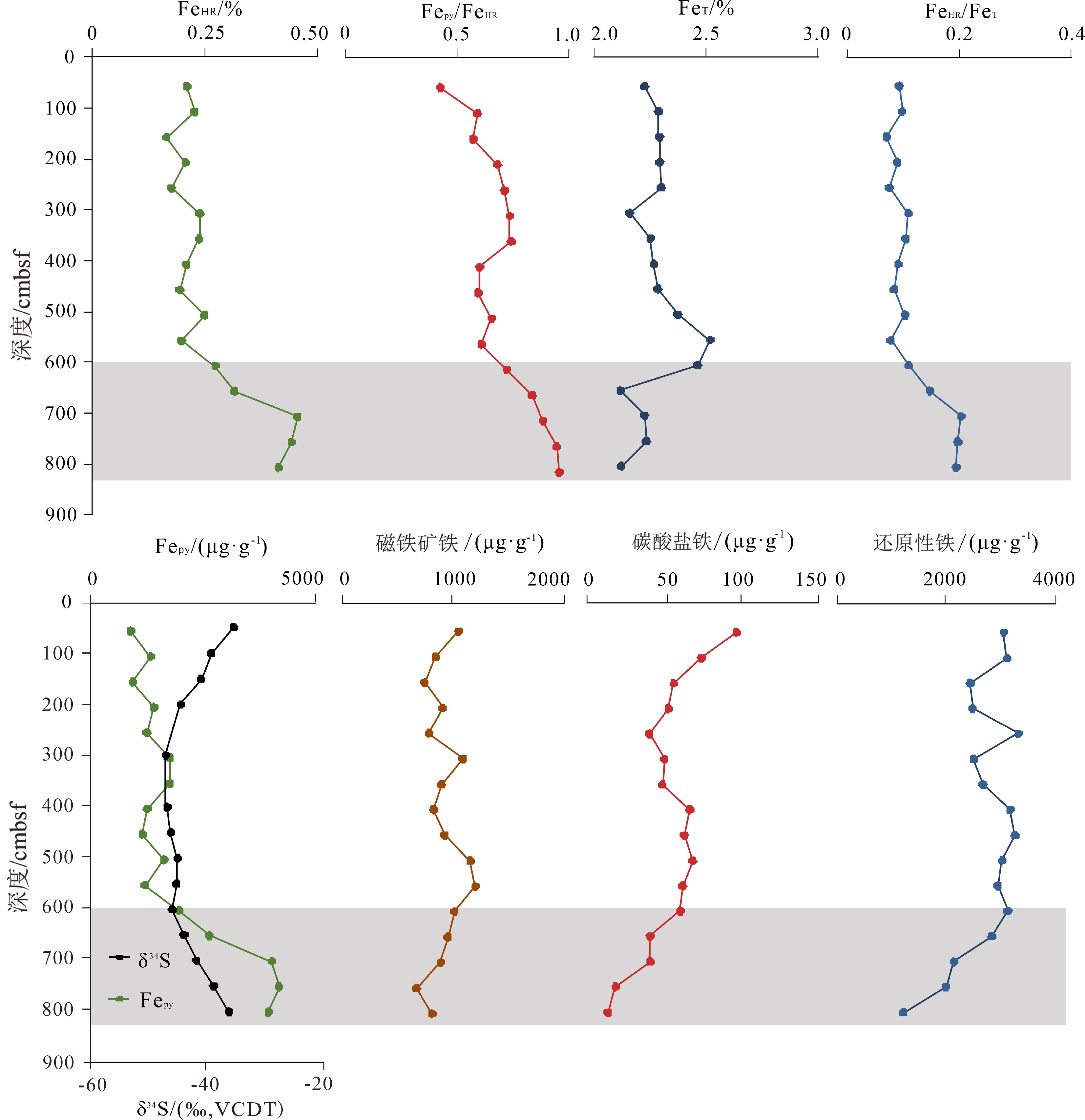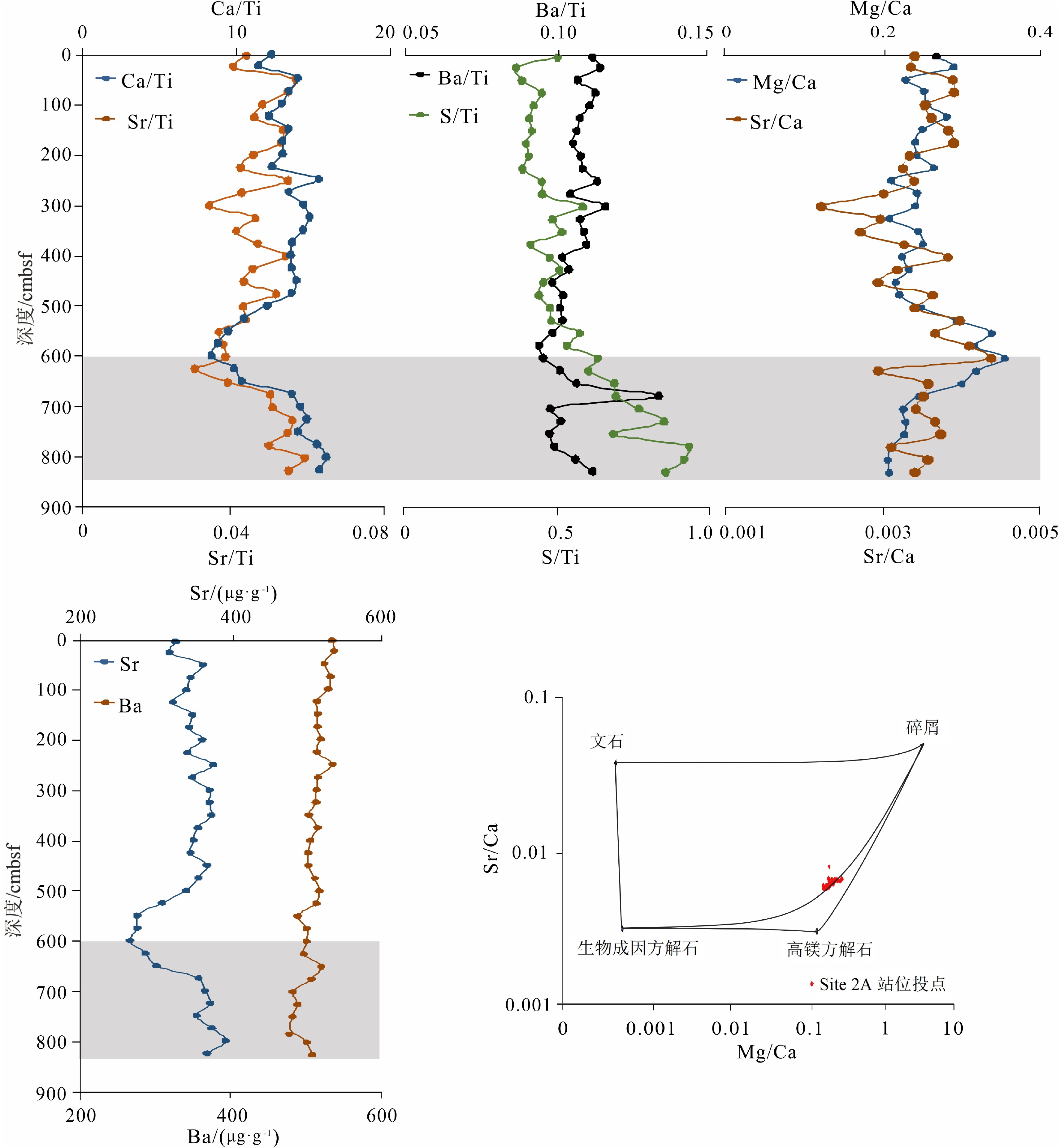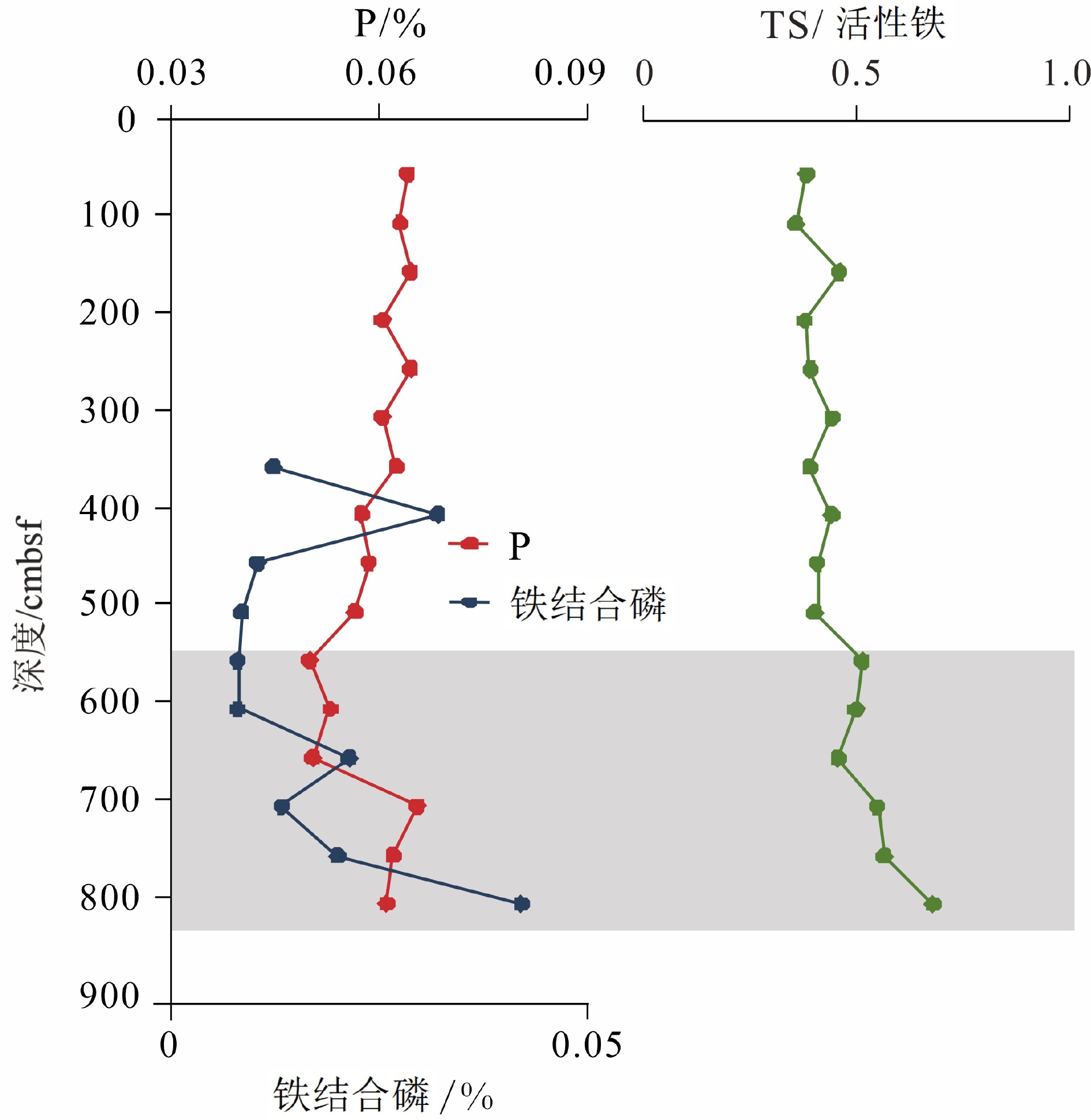Fe-P-S geochemical characteristics of sediments in the Shenhu area of northern South China Sea and their implications for methane leakage
-
摘要: 神狐海域是我国天然气水合物勘探试采的重点区域,在甲烷渗漏过程中会形成黄铁矿和蓝铁矿等具有指示意义的矿物,这些矿物和Fe、P、S等元素密切相关,通过Fe-P-S等元素地球化学特征来研究该区域的甲烷渗漏对进一步了解南海水合物的成藏状况有重要意义。本研究选取南海北部神狐海域Site 2A柱状沉积物为研究对象,通过对其主微量元素、铁结合磷、自生磷灰石态磷、碳酸盐铁、磁铁矿铁、还原性铁、铬还原硫、硫同位素以及总有机碳(TOC)等数据分析,研究该地区的Fe、P和S等元素之间的关系以及对甲烷渗漏的指示。研究发现,在600 cmbsf(centimeter below sea floor)深度以下的初级生产力水平随深度增加而略有升高。在600 cmbsf深度以下,沉积物中可指示黄铁矿的铬还原硫含量增加,其硫同位素明显正偏,说明可能存在甲烷厌氧氧化作用,根据沉积物中指示富镁方解石和文石的Mg/Ca和Sr/Ca、与自生碳酸盐有关的Sr/Ti和Ba/Ti均在600 cmbsf出现了峰值,以及铁结合磷和自生磷灰石态磷含量的增加,可推测600 cmbsf左右为硫酸盐—甲烷转换带(SMTZ)的上界。另外,铁结合磷的含量在SMTZ带明显增加,黄铁矿中的铬还原硫以及δ34S可以指示黄铁矿的含量,从而可以利用不同形态的Fe、P和S元素地球化学特征指示和识别甲烷渗漏。Abstract: The Shenhu area is a key area in China for gas hydrate exploration and trial production. Research results suggest that such elements as Fe-P-S, are easily affected by the anaerobic oxidation of the methane (AOM) to form the minerals of pyrite and viviante. To study the methane seep intensity and hydrate accumulation potential of the area through Fe-P-S and other elements and their geochemical characteristics has reference significance for further understanding the gas hydrate accumulation mechanisms. In this paper, the core sediments from the Site 2A of the Shenhu area in the north of South China Sea are selected as the research target. Upon the basis of previous studies, the relationship among Fe, P, S and their implications for methane leakage are studied with the analysis data of major and trace elements, iron-bound phosphorus, authigenic apatite phosphorus, carbonate iron, magnetite iron, reducing iron, chromium-reduced sulfur (CRS), sulfur isotopes, and total organic carbon (TOC). All the data of TOC, P/Ti, Al/Ti, Ba/Ti, high active iron (FeHR) and other productivity indicators from the Site 2A station indicate a medium level of primary productivity. The primary productivity below 600 cmbsf (centimeter below sea floor) in water depth increases slightly deepwards. CRS content increases below 600 cmbsf and its sulfur isotope is obviously positive, which indicates the existence of AOM. The Mg/Ca and Sr/Ca are indicators of high magnesium calcite and aragonite in sediments, and Sr/Ti and Ba/Ti contents related to authigenic carbonate. They all leave peaks at 600 cmbsf, and the water around this depth, the contents of Iron-bound phosphorus and Authigenic apatite phosphorus are also high. Therefore, we speculate that the depth of 600 cmbsf is most probably the upper boundary of Sulfate Methane Transition Zone (SMTZ). The research further suggests that the content of iron-bound phosphorus increases significantly in the SMTZ, CRS and δ34S in pyrite and may indicate the content of pyrite, so that methane seep can be recognized by different forms of Fe, P and S elements.
-
Keywords:
- methane seep /
- paleo-productivity /
- elemental geochemistry /
- AOM /
- Shenhu area
-
X射线荧光(X-ray Fluorescence,XRF)是一种测定各种材料化学成分的分析方法。其原理是利用初级X射线照射以激发待测样品中的原子,使之产生荧光(次级X射线),以单位时间内各元素(Na–U)X荧光信号计数作为元素丰度,获得样品中元素组成与含量[1]。该方法具有快速、无损、分辨率高以及样品制备简便等优点[2-3],广泛应用于地质、环境、材料和冶金等诸多领域的主微量元素分析和化学分析[4]。在古气候与古海洋学的研究中,通常利用XRF岩芯扫描提供的沉积物各元素浓度或比值,重建陆表风化强度[5]、分析沉积物物源[6-7]、估算古海洋初级生产力[8]等,但扫描结果的准确性受沉积物含水量、孔隙度、矿物组成、粒度等影响[5-6]。海洋沉积物中不同元素具有不同的环境指示意义。例如,Ca元素含量通常用于指示海洋钙质生物的生产力[9];元素Al、K、Ti在多数研究中被认为与海洋沉积物的陆源组分含量直接相关[10-13];Zr元素一般与沉积物中粗颗粒含量有很高的相关性,或可指示水动力条件变化[14]。基于XRF测定的元素比值也常被用来指示海洋环境变化,如海洋沉积物Ti/Ca和Fe/Ca通常用于重建大陆边缘附近的陆源通量,其值越高表明陆源物质的输入越多[15-17];Sr/Ca比值变化与颗石藻的钙化和生长速度具有良好的正相关性[18],可用来指示古海洋初级生产力变化[19];Ti/Al、K/Al和K/Ti常用于追踪陆表风化和侵蚀的变化,较高的值指示较强的陆表风化作用[20-23];Zn/Al代表海洋营养状况,其值较高表明海洋营养状况较好[24]。
大洋钻探通过获取海底沉积物和岩石样品,为海洋地质研究提供关键材料,是目前对海洋地质历史研究最有效、最直接的方法[25]。国际大洋发现计划(IODP)是地球科学领域规模最大、参加国家最广泛、持续时间最长的国际合作研究计划[25-26],通过大洋钻探采集和分析海洋沉积物岩芯样品,重建地质历史时期生物圈、水圈、大气圈以及岩石圈之间的生物地球化学循环、通量和相互作用[26]。XRF岩芯扫描作为IODP常用、扫描间隔可达毫米级的一种样品分析方法,在研究过去长时间尺度的高分辨率气候与海洋变化中发挥了重要作用[5, 27]。IODP现阶段XRF岩芯扫描原始数据只提供元素计数,无法直接获得元素含量。由于各元素的特征X射线强度不仅与该元素的含量有关,而且与共存元素的含量有关,因此XRF元素计数只能大致表示元素含量的相对变化趋势,不能满足古海洋古气候研究对元素含量变化的需求。为了探索如何充分利用IODP高分辨率XRF数据进行古海洋研究,本文以IODP 385航次U1546站位XRF岩芯扫描数据为例,结合标准样与离散沉积物样品元素浓度的XRF实测数据,建立元素计数与其含量之间的对应关系,进而将XRF原始扫描数据的元素计数转换为对应元素含量,在此基础上利用相关元素含量及比值的变化,重建瓜伊马斯盆地中更新世(350 ka)以来陆表风化强度、陆源物质输入、海洋营养与初级生产力情况。
1. 研究区域概况
1.1 地质背景
加利福尼亚湾位于北美大陆和加利福尼亚半岛之间(图1),是东太平洋北部的一个狭长的边缘海,属于非常年轻的被动大陆边缘裂谷[28]。湾内由一系列狭长的转换断层和短小的新生洋脊组成,隶属于东太平洋海隆最北端。瓜伊马斯盆地(Guaymas Basin)位于加利福尼亚湾南部和北部的交界处,是东太平洋海隆的核心[29]。该盆地内板块活动非常强烈,岩浆活动和周围陆表径流带来大量的营养物质,促进了海洋表层的初级生产力,加之周围流域大量的河流陆源输入,共同导致了较高的沉积速率(约1~3 mm/a )[28-29]。因此瓜伊马斯盆地发育厚约1~2 km、富含有机质的沉积序列,为高分辨率古海洋学研究提供了宝贵的材料。
1.2 钻孔概况
IODP 385航次于2019年在瓜伊马斯海盆执行,该航次共在8个站位进行了取样,编号为U1545—U1552(图1)。本研究样品与XRF岩芯扫描数据均来自U1546站位,位于瓜伊马斯盆地北部扩张断裂带西北约51 km处,是该航次钻进深度最大的站位。U1546站位由A、B、C、D 4个钻孔组成,其中U1546A孔(27°37ʹ53.11″N、 111°52ʹ47.63″W)水深
1586 m,终孔深度为361.2 m。2. 材料与方法
2.1 样品与数据来源
本研究样品来源于IODP385航次U1546A钻孔0~290.7 m岩芯样品,该钻孔的XRF岩芯扫描数据来自于IODP网站(http://iodp.tamu.edu)。IODP使用波长色散式XRF,在3种不同电压下对U1546A孔沉积物岩芯进行了扫描[30],以获得不同元素的计数:10 kV(无过滤器)用于测量主量和微量元素(即Mg、Al、Si、K、Ca、Ti、Mn、Fe、Cr、P和S);30 kV (使用Pd过滤器)用于测量较重的主量元素以及与地质有关的微量元素(即Ca、Ti、Mn、Fe、Ni、Sr、Rb、Zr和Zn);50 kV(使用Cu过滤器)用于测量较重的微量元素(即Sr、Rb、Zr和Ba)。不同电压条件下,各元素测试结果有所不同,通常较高的电压能激发更多的元素,但会降低测试结果的准确性,因此较低的电压更适合测量轻元素[4]。为确保准确性,本文选取10 kV条件下的Al、K、Ca、Ti、Fe元素计数和30 kV条件下的Sr、Rb、Zr、Zn元素计数作为研究数据。
2.2 沉积物样品XRF测试
从0~290.7 m沉积物岩芯样品中,平均每隔6 m选取1个样品,共选出48个样品,并确保各样品深度与XRF岩芯扫描数据(深度间隔2 cm)中各深度对应。使用玛瑙研钵将所选样品研磨,过200目筛后,称取0.9~1.0 g倒入标准模具中,在大于30 MPa压力下将样品压成薄片。使用天瑞(EDX6000B)X荧光光谱仪进行测试,每个样品测量10遍,测试时使用水系沉积物成分分析标准物质(GBW07305a)进行校准,剔除异常值后取平均值得出元素含量,元素含量检测相对误差均小于5%。实验在暨南大学地下水与地球科学研究院完成。
2.3 建立标准曲线
将所得元素含量与XRF原始数据的元素计数进行线性回归,发现Al、Fe、K、Ti、Ca、Zn、Rb、Zr、Sr等元素的计数与含量具有显著相关性(p<0.05;图2),获得各元素计数与含量转换的标准曲线(图2)。利用标准曲线分别计算出0~290.7 m范围内各深度上述9个元素的含量(图3)。由于数据量庞大,使用R中的Loess Fit模型进行平滑处理,以获得明显的变化趋势(图3)。
3. 结果与讨论
前人根据瓜伊马斯盆地U1546站位碳酸钙与深海氧同位素阶对比,建立了年代框架,确定瓜伊马斯盆地中更新世(290~440 ka)及全新世至中更新世(0~290 ka)对应的区间分别为249.3~352.1 m和0~249.3 m,沉积速率分别为69 cm/ka和86 cm/ka[31],据此获得每个样品的地质年代,确定U1546站位0~290.7 m沉积深度对应年代为0~350 ka。
3.1 沉积物元素含量特征
前人研究表明,Al、K、Fe元素主要赋存于表生环境下地球化学性质较为稳定的碎屑沉积物中[32],因此海洋沉积物中Al、K、Fe元素含量通常作为表征陆源碎屑输入多少的代用指标[12-13],这些元素在海洋沉积物中含量越高指示陆源物质输入越多。Ti是典型的亲石元素[33],主要分布在重矿物中[34],在化学风化和搬运沉积过程中不容易发生迁移,且由于本身具有较强的抗化学风化的特性,使得Ti元素含量能够有效地指示海洋沉积环境中的陆源物质输入情况[35]。Zn元素含量与海洋有机碳输入正相关[36],常被用作指示海洋营养状况[37]。Zr和Rb元素在岩石风化过程中不活泼,通常与固体物质结合或被吸附,随颗粒物一起搬运和沉积,它们在海水中的含量极少,在自生物质中的富集程度很低[38]。因此在海底沉积物中,Zr和Rb元素几乎全部来自碎屑物质,反映碎屑源区的地球化学特征[39-40]。在某些情况下,Zr和Rb元素还可以指示沉积物粒度,Zr元素多赋存于重矿物中,一般与粗颗粒沉积物含量呈现正相关[14],而Rb元素与细颗粒沉积物含量正相关[41]。海洋沉积物中Ca元素含量变化通常反映海洋浮游生物生产CaCO3能力的变化[11],而Sr作为亲生物元素,其地球化学行为与CaCO3相似[38],其含量可指示颗石藻等钙化生物的生产力情况[18],因此Ca和Sr元素可用于恢复古生产力。
瓜伊马斯盆地沉积物元素含量在过去350 ka发生了明显变化(表1,图3),将其平均值与上地壳(UCC)标准值[42]对比发现(表1,图4),该区海洋沉积物中Al、Fe、K、Ti含量均偏低,与航次报告中的这些元素含量偏低描述一致[30],表明陆源物质输入不占主导地位。Zn元素含量高于UCC标准值,表明海洋营养环境较好,初级生产力高。Ca元素含量变化范围为0~5%,平均值为1.74%,低于UCC标准值;Sr元素含量整体略低于UCC标准值。较低的Ca和Sr元素含量表明,瓜伊马斯盆地更新世(0~290 ka)以来海洋环境中钙质生物不占主导地位,这与沉积物化石群落以硅藻占据绝对优势的情况吻合[28]。较高的Rb元素含量和较低的Zr元素含量表明,沉积物主要以细粒为主,这与航次报告中的沉积物岩性描述一致[28]。
表 1 瓜伊马斯盆地沉积物元素含量Table 1. Elemental contents of sediments in the Guaymas Basin元素 含量范围/% 平均值/% 上地壳/% Al 2.36~4.37 3.23 8.15 Fe 0.54~2.81 1.27 3.53 K 0.39~1.23 0.84 2.32 Ti 0.09~0.41 0.16 0.38 Ca 0.24~18.97 1.74 2.56 Zn 0.008~0.03 0.013 0.0067 Rb 0.0055 ~0.0091 0.0076 0.0084 Zr 0.0022 ~0.0153 0.0092 0.0193 Sr 0.0049 ~0.0520.021 0.032 从元素含量随时间变化的情况看,Ti、Zr、Rb元素与Al、K、Fe等表征陆源输入的元素变化趋势一致(图3),可能说明以上这些元素主要来自陆源,广泛存在于黏土矿物和轻重矿物中。这些元素均从350 ka以来逐渐减少,表明中更新世(0~290 ka)以来瓜伊马斯盆地的陆源物质输入逐渐减少。Zn元素含量变化与Al、K、Ti元素变化趋势基本一致(图3),表明瓜伊马斯盆地海洋初级生产力主要受陆源物质输入影响,可能与来自陆地的营养盐输入有关。Ca和Sr元素变化趋势基本一致(图3),且整体变化幅度不大,仅在350~250 ka出现大幅波动,250 ka以来呈平稳状态,表明中更新世以来瓜伊马斯盆地钙质生物生产力总体上没有发生明显变化。
3.2 陆表风化强度
在研究陆表风化作用时,元素地球化学指标的原理是选用风化过程中迁移性差异大的主量或微量元素,以此衡量化学风化的强度[22]。随着源区母岩遭受风化,K、Na、Ca等易迁移碱金属元素被淋滤而流失,而A1、Zr、Ti等相对稳定的元素占比增加[43],因此海洋沉积物中K/Al比值和K/Ti比值可用于追踪源区风化强度变化[21-23],其值越小指示风化作用越强。由于Ti和Al分别趋于在粗颗粒和细颗粒沉积物中富集,使得Ti/Al比值被称为粒度敏感指标,在湿热气候条件下比值较大[38],因此海洋沉积物中Ti/Al比值可指示气候变化[44]。瓜伊马斯盆地的Ti/Al、K/Al、K/Ti比值具有相似的变化趋势(图5),从350 ka至今整体呈周期性变化趋势,说明瓜伊马斯盆地周围陆表风化强度具有周期性变化。陆表化学风化过程主要受气候、构造、地形、水文特征、植被以及岩性等因素影响[22]。将其与海洋同位素阶(Marine Isotope Stages,MIS)[45]对比发现, K/Al、K/Ti比值在冰期升高(如MIS2、MIS8)或处于高值(如MIS4),而在间冰期降低(如MIS3)或处于相对低值(如MIS5、MIS9),而Ti/Al比值变化与之相反。推测瓜伊马斯盆地物源区风化强度可能受气候变化控制,大致呈现冰期较弱、间冰期较强的周期性变化特征。
前人研究发现,在不同的构造环境下,化学风化作用受控于多种影响因素[22, 46-47]。在构造不活跃地区,风化作用强度主要受新鲜物质供给(物理剥蚀)速率影响,当构造活动增强时,新鲜岩石的剥蚀速率增加,化学风化作用随之增强[46];而在构造十分活跃的地区,物理剥蚀速率高,新鲜岩石物质供给充足,同时由于强烈的构造变形能加快矿物与水、酸的反应速率,此时化学风化强度主要受控于气候因素,温度升高和降水增多会显著地增强化学风化强度[47-48]。瓜伊马斯盆地位于东太平洋洋中脊上,是东太平洋海隆的核心,紧邻太平洋板块和北美板块界线,因此该地区构造活动强烈,地震频繁[31]。在此构造背景下,瓜伊马斯盆地周围的陆表风化强度主要受冰期-间冰期周期性气候变化影响,同时也解释了Ti/Al、K/Al、K/Ti比值出现周期性变化的原因。
3.3 陆源物质输入
海洋沉积物来源包括陆源、火山源、生物源和自生等多个来源,可通过选取不同元素组合(如Si/Al、Fe/Al)来指示物质来源[49-50]。前人研究发现,典型的火山源物质Fe/Al比值为0.73,生物源物质比值为1.56,太平洋陆源深海黏土比值为0.61[50]。研究区沉积物Fe/Al比值范围介于0.25~0.68,平均值为0.39,低于火山源和生物源比值,表明研究区表层沉积物中火山源和生物来源物质较少。Dean等[51]通过研究加利福尼亚大陆边缘沉积物中Fe、Ti、Li等元素与Al含量之间的关系,发现这些元素均来自于陆源,结合Fe/Al比值推测其研究区沉积物的主要来源是陆源碎屑。瓜伊马斯盆地位于加利福尼亚湾,该海湾是科罗拉多河最终汇入海域,因此受到比较强烈的海陆交互作用影响。其潜在沉积物来源包括西马德雷山脉西坡(Sierra Madre)、科罗拉多河和加利福尼亚半岛[31, 52-53],但因加利福尼亚半岛地势低洼,河流稀少,并不是主要沉积物源[54]。因此,瓜伊马斯盆地沉积物可能主要来源于马德雷山脉西坡和科罗拉多河输入,但确定这两个来源的相对比例需要进一步研究。
海洋沉积物Ti和Fe元素含量与通过河流、风力搬运作用输送到海洋的陆源沉积物含量呈正相关[12-13],而Ca元素含量通常被认为是海洋自生的生物成因组分,其与海洋浮游生物生产的CaCO3含量呈正相关[11],因此Ti/Ca与Fe/Ca比值可用于指示大陆边缘附近的陆源通量,其较高的比值表示较高的陆源物质输入[15-17]。研究区Ti/Ca与Fe/Ca比值变化趋势相似(图5),呈明显阶段性变化。在350~130 ka期间,特别是在MIS8期间(300~243 ka),其值较大且变化较大,自MIS5开始(130 ka),这些比值大幅降低,130 ka至今,变化幅度较小且整体呈缓慢上升趋势。Ti/Ca与Fe/Ca比值在晚更新世和全新世整体低于中更新世,反映350 ka以来陆源物质输入量逐渐减少且趋于平稳,这与前文Al、Ti、K、Fe等元素指示的陆源物质输入变化一致。陆源物质输入通常会受河流流量、大陆气候、相对海平面和沉积环境等因素影响[12]。将瓜伊马斯盆地陆源物质输入与周围陆表风化强度对比(图5)发现,在350~130 ka期间,陆源输入指标Ti/Ca、Fe/Ca比值与风化强度指标Ti/Al、K/Al、K/Ti比值大致呈正相关;130~60 ka期间,Ti/Al、K/Al、K/Ti比值呈现同向周期性变化,而Ti/Ca、Fe/Ca比值比较稳定。这些变化表明,瓜伊马斯盆地陆源物质输入在350~130 ka期间可能主要受周围陆表风化强度影响,而130~60 ka期间可能有其他一个或多个因素影响了陆源物质输入。
3.4 海洋营养及初级生产力
在古海洋研究中,通常利用元素与Al等稳定元素的比值进行标准化,来消除沉积物中矿物和粒度变化对元素含量的影响[55],因此Zn/Al比值相比于Zn元素能更好地指示海洋营养状况,成为指示海洋营养状况的重要指标[24]。瓜伊马斯盆地Zn/Al比值在过去350 ka以来有明显的变化(图5),350~130 ka期间变化较大,自MIS5(130 ka)以来整体呈上升趋势,直至MIS1期间达到最大值,表明其海洋营养状况逐渐变好。将瓜伊马斯盆地营养状况与陆源物质输入对比(图5),发现二者变化趋势相似,均在350~130 ka期间变化幅度较大,130 ka以来逐渐增加。瓜伊马斯盆地沉积物主要来源于科罗拉多河、自生浮游植物、热液沉积物等[53, 56-57]。前人研究发现中更新世以来,科罗拉多河带来的陆源物质快速增加,自生浮游植物和热液沉积物的贡献整体较少[31],与研究区营养状况变化大体一致。具体来说,中更新世以来,营养状况与陆源物质输入变化趋势逐渐同步,特别是从晚更新世开始,二者变化基本一致,均呈稳定增加趋势,据此推测瓜伊马斯盆地350 ka以来的营养物质来源主要受陆源物质输入影响。
前人通过室内颗石藻培养实验和表层沉积物分析发现,沉积物中Sr/Ca比值与颗石藻的生长和钙化速度具有良好的相关性[18, 58],现代腹足类壳体实验结果表明Sr元素的原始含量不受化学沉积作用影响[59],因此Sr/Ca比值可作为指示钙质生物生产力变化的可靠指标[18, 58]。瓜伊马斯盆地Sr/Ca比值在中更新世期间(350~130 ka)变化幅度很大,从晚更新世开始其波动幅度显著减小(图5),这与陆源输入指标Ti/Ca、Fe/Ca比值变化趋势基本一致。海洋初级生产力大小通常受营养状态、温度、季风强度、区域环流、陆源物质输入、海平面变化等多种因素影响[60]。根据图5,表征海洋初级生产力与陆源物质输入的指标随时间变化表现出明显的正相关关系,陆源物质输入增加,初级生产力随之升高,表明瓜伊马斯盆地350 ka以来的海洋初级生产力变化主要受陆源物质输入影响。前人综合研究古海洋营养指标与古生产力指标之间的对应关系发现,通常海洋初级生物生产力大小取决于表层水体的营养物质丰富程度,营养物质越丰富,生物越繁盛,光合作用固碳能力越强,生产力越大[37]。瓜伊马斯盆地海洋初级生产力变化与营养状况变化一致,表现为Zn/Al比值升高时,Sr/Ca比值同样升高,反之,Zn/Al比值降低时,Sr/Ca比值降低,具有明显的正相关关系,反映了营养盐对初级生产力的控制作用。
4. 结论
(1)瓜伊马斯盆地流域的陆表风化强度与海洋同位素阶呈现出显著的周期性相关性。具体而言,陆表风化强度在冰期较低、间冰期较高,这一变化趋势与气候的周期性波动紧密相关。
(2)研究区沉积物的来源分析显示,其主要来自陆源物质。350~130 ka期间,陆源物质输入经历了剧烈变化,这一变化主要受陆表风化强度的影响。而自130 ka以来,陆源物质输入量逐渐增加,且影响因素发生了转变,可能与全球气候变化及区域地质活动有关。
(3)研究区海洋营养程度和初级生产力的变化趋势相似,均在350~130 ka期间表现出较大波动,并自130 ka以来逐渐增加。通过Sr/Ca和Zn/Al的分析,推断这两者的变化主要受陆源物质输入的影响。此外,结合物源分析结果,认为陆源物质的输入不仅影响了海洋的营养状态,而且对海洋初级生产力产生了重要影响。
致谢:实验过程中得到了暨南大学苏虹高级工程师的协助。
-
图 4 Site 2A岩芯沉积物中高活性铁(FeHR)、总铁(FeT)、δ34S、黄铁矿铁(Fepy)、磁铁矿铁、碳酸盐铁、还原性铁、FeHR/FeT、Fepy/FeHR变化趋势图
FeHR为碳酸盐铁和黄铁矿铁的和,其中黄铁矿铁为铬还原硫数据的换算。
Figure 4. High active iron (FeHR), total iron(FeT), δ34S、pyrite iron, carbonate iron, reducing iron, FeHR/FeT、Fepy/FeHR of core sediments from Site 2A
FeHR is the sum of carbonate iron and pyrite iron, where pyrite iron is the conversion of chromium-reduced sulfur data.
表 1 Site 2A岩心沉积物的主量元素组成
Table 1 Major element composition of core sediments from Site 2A
样品编号 深度 Si Al Ca Fe Mg Ti S Mn P Site 2A-001 1 25.15 8.59 5.96 2.31 1.60 0.49 0.24 0.09 0.07 Site 2A-006 23 24.77 8.49 5.46 2.26 1.59 0.48 0.17 0.07 0.06 Site 2A-011 48 23.86 8.28 6.97 2.21 1.60 0.50 0.18 0.08 0.07 Site 2A-016 73 23.85 8.18 6.44 2.25 1.63 0.48 0.21 0.07 0.06 Site 2A-021 98 23.87 8.25 6.28 2.27 1.61 0.49 0.20 0.07 0.06 Site 2A-026 123 23.93 8.27 5.88 2.31 1.65 0.49 0.19 0.08 0.07 Site 2A-031 148 23.76 8.22 6.56 2.31 1.64 0.49 0.20 0.07 0.07 Site 2A-036 173 23.27 8.13 6.45 2.28 1.56 0.50 0.19 0.08 0.06 Site 2A-041 198 23.70 8.16 6.36 2.29 1.55 0.49 0.19 0.07 0.07 Site 2A-046 223 23.49 8.04 5.92 2.31 1.57 0.48 0.18 0.08 0.06 Site 2A-051 248 23.53 8.15 7.38 2.28 1.56 0.48 0.21 0.08 0.07 Site 2A-056 273 24.19 8.20 6.71 2.33 1.64 0.50 0.22 0.08 0.06 Site 2A-061 298 23.49 7.95 6.45 2.12 1.56 0.45 0.25 0.06 0.06 Site 2A-066 323 23.79 7.89 7.13 2.21 1.49 0.48 0.23 0.06 0.06 Site 2A-071 348 23.93 8.34 6.72 2.24 1.65 0.47 0.23 0.07 0.06 Site 2A-076 373 24.23 8.45 6.48 2.26 1.63 0.48 0.19 0.07 0.06 Site 2A-081 398 24.23 8.21 6.83 2.29 1.54 0.50 0.23 0.06 0.06 Site 2A-086 423 24.04 8.17 6.66 2.25 1.56 0.49 0.24 0.07 0.06 Site 2A-091 448 23.94 8.10 7.20 2.27 1.56 0.52 0.23 0.07 0.06 Site 2A-096 473 23.53 8.16 6.92 2.31 1.53 0.51 0.22 0.06 0.06 Site 2A-101 498 23.99 8.32 6.23 2.38 1.55 0.52 0.24 0.07 0.06 Site 2A-106 523 23.53 8.22 5.35 2.37 1.57 0.51 0.24 0.09 0.05 Site 2A-111 548 23.56 8.06 4.75 2.50 1.61 0.50 0.28 0.10 0.05 Site 2A-116 573 22.80 8.01 4.73 2.54 1.50 0.54 0.28 0.11 0.05 Site 2A-121 598 23.52 8.27 4.43 2.52 1.57 0.53 0.33 0.09 0.05 Site 2A-126 623 23.75 8.35 4.90 2.41 1.56 0.50 0.29 0.10 0.06 Site 2A-131 648 23.92 8.44 5.13 2.44 1.54 0.50 0.33 0.10 0.06 Site 2A-136 673 19.80 7.19 5.22 1.80 1.29 0.38 0.26 0.06 0.05 Site 2A-141 698 24.15 8.22 7.06 2.24 1.60 0.50 0.37 0.08 0.07 Site 2A-146 723 24.32 8.29 7.12 2.22 1.63 0.49 0.41 0.10 0.07 Site 2A-151 748 24.30 8.32 6.99 2.28 1.59 0.50 0.33 0.09 0.06 Site 2A-156 773 24.14 8.04 7.44 2.20 1.57 0.49 0.45 0.09 0.06 Site 2A-161 798 23.61 7.74 7.57 2.10 1.57 0.48 0.43 0.08 0.06 Site 2A-166 823 22.64 7.54 7.08 2.15 1.48 0.46 0.39 0.08 0.06 注:深度单位为cmbsf,元素单位为%。 表 2 Site 2A岩心沉积物的部分稀土微量元素组成和有机碳含量
Table 2 Rare earths elements, trace elements and TOC of core sediments from Site 2A
样品编号 深度 V Cr Ni Rb Sr Zr Ba Th U TOC Site 2A-001 1 121 72.9 46.3 120 310 134 543 11.4 2.31 0.621 Site 2A-006 23 119 72.6 44.8 121 301 138 546 11.5 2.99 0.629 Site 2A-011 48 114 68.5 44.2 114 349 131 532 10.8 3.08 0.853 Site 2A-016 73 115 70.6 43.2 117 331 133 541 11.3 3.06 0.772 Site 2A-021 98 116 71.4 43 119 325 130 538 11.4 3.09 0.662 Site 2A-026 123 115 72.1 42.7 120 306 137 522 11.5 2.89 0.600 Site 2A-031 148 118 71.2 43.5 119 334 135 523 11.2 3.02 0.661 Site 2A-036 173 118 74.7 44.1 119 329 137 522 11.4 3.09 0.592 Site 2A-041 198 118 71.6 44.4 117 348 133 527 12.2 3.28 0.779 Site 2A-046 223 113 72.6 42.2 120 327 136 522 11.6 3.12 0.575 Site 2A-051 248 115 71.4 43.9 119 363 134 544 11.3 3.27 0.641 Site 2A-056 273 114 71.7 43.2 117 334 132 523 11.4 3.12 0.642 Site 2A-061 298 114 71.5 44.7 116 358 136 521 11.6 3.27 0.669 Site 2A-066 323 115 75.2 44.8 120 358 137 520 11.7 3.22 0.614 Site 2A-071 348 110 71 41.8 117 360 133 511 11.5 3.17 0.604 Site 2A-076 373 114 75.4 43.7 124 342 140 522 12.1 3.18 0.622 Site 2A-081 398 111 73.9 43.7 119 335 132 513 11.8 3.35 0.642 Site 2A-086 423 112 75.1 44.2 121 331 139 509 11.9 3.19 0.596 Site 2A-091 448 118 77.2 47 124 355 136 510 12 3.39 0.666 Site 2A-096 473 118 77.5 47.8 123 342 134 519 11.8 3.37 0.661 Site 2A-101 498 117 79.8 48.1 130 325 138 525 12.6 3.62 0.678 Site 2A-106 523 117 80 48.8 129 291 132 521 12.2 3.15 0.738 Site 2A-111 548 114 80 49 132 256 135 495 12.3 2.98 0.752 Site 2A-116 573 118 83.5 50.5 137 256 136 507 12.8 3.22 0.900 Site 2A-121 598 116 83.9 51.4 139 246 133 507 13 3.17 0.798 Site 2A-126 623 117 82.1 49.8 135 267 130 503 12.8 3.14 0.773 Site 2A-131 648 116 81.1 49.6 136 282 132 528 12.7 3.21 0.884 Site 2A-136 673 116 75 46.1 125 342 134 514 12.1 3.24 0.816 Site 2A-141 698 112 73.4 45.4 119 351 137 487 11.5 3.16 0.951 Site 2A-146 723 114 73.7 44.8 119 359 134 494 11.6 2.97 0.937 Site 2A-151 748 111 72.8 43.8 120 340 136 487 11.5 2.91 0.868 Site 2A-156 773 107 69.2 44.1 115 361 134 484 11.3 3.11 1.030 Site 2A-161 798 109 70.6 46.9 113 381 132 507 11.1 3.31 0.996 Site 2A-166 823 109 71.4 44.9 117 355 134 515 11.4 3.31 0.932 注:深度单位为cmbsf,稀土微量元素单位为μg·g−1,TOC单位为%。 表 3 Site 2A岩心沉积物的铁氧化物结合态磷、自生磷灰石态磷、黄铁矿铁、碳酸盐铁和还原性铁含量以及δ34S数据
Table 3 Iron-bound phosphorus, authigenic apatite phosphorus, pyrite iron (Fepy), carbonate iron, reducing iron and δ34S of core sediments from Site 2A
样品编号 深度 自生磷灰石态磷 铁结合磷 黄铁矿铁 碳酸盐铁 还原性铁 磁铁矿铁 δ34S-VCDT Site2A-013 58 1 480 90 900 96.4 3 050 1 050 −36.6 Site2A-023 108 1 770 1 610 348 73.8 3 110 842 −40.8 Site2A-033 158 1 470 1 600 946 56.0 2 430 741 −42.7 Site2A-043 208 1 490 1 600 1 420 52.6 2 470 905 −46.4 Site2A-053 258 1 500 1 370 1 260 40.4 3 310 784 − Site2A-063 308 1 530 210 1 760 49.9 2 490 1 090 −49.3 Site2A-073 358 1 160 133 1 760 48.7 2 660 895 −47.1 Site2A-083 408 1 270 329 1 260 66.4 3 170 823 −49.0 Site2A-093 458 1250 114 1 160 62.9 3 260 922 −48.3 Site2A-103 508 1090 95 1 640 68.2 3 020 1 150 −47.1 Site2A-113 558 1200 90 1 210 61.9 2 930 1 200 −47.3 Site2A-123 608 927 90 1 980 60.4 3 130 1 010 −48.1 Site2A-133 658 994 224 2 640 40.9 2 820 950 −45.9 Site2A-143 708 1 300 142 4 040 41.0 2 130 888 −43.5 Site2A-153 758 1 300 210 4 190 18.8 1 980 672 −40.3 Site2A-163 808 1 290 430 3 960 13.7 1 200 811 −37.4 注:深度单位为cmbsf,磷和铁的单位为μg·g−1,S同位素单位为‰。 -
[1] Collett T S. Natural gas hydrates of the prudhoe bay and kuparuk river area, north slope, alaska [J]. AAPG Bulletin, 1993, 77(5): 793-812.
[2] Dallimore S R, Collett T S, Weber M, et al. Drilling program investigates permafrost gas hydrates [J]. Eos Transactions American Geophysical Union, 2002, 83(18): 193-198.
[3] 金丽娜, 于兴河, 董亦思, 等. 琼东南盆地水合物探区第四系深水沉积体系演化及与BSR关系[J]. 天然气地球科学, 2018, 29(5):644-654 JIN Li’na, YU Xinghe, DONG Yisi, et al. The evolution of Quaternary depositional system in gas hydrate exploration area in Qiongdongnan Basin and its relationship with BSR [J]. Natural Gas Geoscience, 2018, 29(5): 644-654.
[4] 李进, 王淑红, 颜文. 海底泥火山及其与油气和天然气水合物的关系[J]. 海洋地质与第四纪地质, 2017, 37(6):204-214 LI Jin, WANG Shuhong, YAN Wen. Seabed mud volcano and its bearing on oil-gas and gas hydrate [J]. Marine Geology & Quaternary Geology, 2017, 37(6): 204-214.
[5] 刘关勇, 王旭东, 黄慧文, 等. 南海北部烟囱状碳酸盐岩记录的冷泉流体活动演化特征研究[J]. 地球化学, 2017, 46(6):567-579 doi: 10.3969/j.issn.0379-1726.2017.06.007 LIU Guanyong, WANG Xudong, HUANG Huiwen, et al. Variations in fluid sources and seepages archived in carbonate chimneys from the northern South China Sea [J]. Geochimica, 2017, 46(6): 567-579. doi: 10.3969/j.issn.0379-1726.2017.06.007
[6] 冯俊熙, 杨胜雄, 梁金强, 等. 南海北部神狐东南海域沉积物孔隙水地球化学特征及其对天然气水合物的指示[J]. 海洋地质前沿, 2017, 33(7):32-44 FENG Junxi, YANG Shengxiong, LIANG Jinqiang, et al. Pore water geochemistry in shallow sediments from southeastern shenhu area of northern south china sea and their implications for gas hydrate occurrence [J]. Marine Geology Frontiers, 2017, 33(7): 32-44.
[7] 何家雄, 钟灿鸣, 姚永坚, 等. 南海北部天然气水合物勘查试采及研究进展与勘探前景[J]. 海洋地质前沿, 2020, 36(12):1-14 HE Jiaxiong, ZHONG Canming, YAO Yongjian, et al. The exploration and production test of gas hydrate and its research progress and exploration prospect in the northern south china sea [J]. Marine Geology Frontiers, 2020, 36(12): 1-14.
[8] Peckmann J, Reimer A, Luth U, et al. Methane-derived carbonates and authigenic pyrite from the northwestern Black Sea [J]. Marine Geology, 2001, 177(1-2): 129-150. doi: 10.1016/S0025-3227(01)00128-1
[9] Jorgensen B B, Böttcher M E, Lüschen H, et al. Anaerobic methane oxidation and a deep H2S sink generate isotopically heavy sulfides in Black Sea sediments [J]. Geochimica et Cosmochimica Acta, 2004, 68(9): 2095-2118. doi: 10.1016/j.gca.2003.07.017
[10] Peketi A, Mazumdar A, Joshi R K, et al. Tracing the Paleo sulfate-methane transition zones and H2S seepage events in marine sediments: An application of C-S-Mo systematics [J]. Geochemistry, Geophysics, Geosystems, 2012, 13(10): Q10007.
[11] Wehrmann L M, Titschack J, Böttcher M E, et al. Linking sedimentary sulfur and iron biogeochemistry to growth patterns of a cold-water coral mound in the Porcupine Basin, S. W. Ireland (IODP Expedition 307) [J]. Geobiology, 2015, 13(5): 424-442. doi: 10.1111/gbi.12147
[12] Borowski W S, Rodriguez N M, Paull C K, et al. Are 34S-enriched authigenic sulfide minerals a proxy for elevated methane flux and gas hydrates in the geologic record? [J]. Marine and Petroleum Geology, 2013, 43: 381-395. doi: 10.1016/j.marpetgeo.2012.12.009
[13] Egger M, Jilbert T, Behrends T, et al. Vivianite is a major sink for phosphorus in methanogenic coastal surface sediments [J]. Geochimica et Cosmochimica Acta, 2015, 169: 217-235. doi: 10.1016/j.gca.2015.09.012
[14] Egger M, Rasigraf O, Sapart C J, et al. Iron-mediated anaerobic oxidation of methane in brackish coastal sediments [J]. Environmental Science & Technology, 2015, 49(1): 277-283.
[15] Liu J R, Izon G, Wang J S, et al. Vivianite formation in methane-rich deep-sea sediments from the South China Sea [J]. Biogeosciences, 2018, 15(20): 6329-6348. doi: 10.5194/bg-15-6329-2018
[16] Wu D D, Xie R, Liu J, et al. Zone of metal-driven anaerobic oxidation of methane is an important sink for phosphorus in the Taixinan Basin, South China Sea [J]. Marine Geology, 2020, 427: 106268. doi: 10.1016/j.margeo.2020.106268
[17] Naehr T H, Eichhubl V, Orphan V J, et al. Authigenic carbonate formation at hydrocarbon seeps in continental margin sediments: a comparative study [J]. Deep Sea Research Part II:Topical Studies in Oceanography, 2007, 54(11-13): 1268-1291. doi: 10.1016/j.dsr2.2007.04.010
[18] Bayon G, Henderson G M, Bohn M. U-Th stratigraphy of a cold seep carbonate crust [J]. Chemical Geology, 2009, 260(1-2): 47-56. doi: 10.1016/j.chemgeo.2008.11.020
[19] Bayon G, Pierre C, Etoubleau J, et al. Sr/Ca and Mg/Ca ratios in Niger Delta sediments: implications for authigenic carbonate genesis in cold seep environments [J]. Marine Geology, 2007, 241(1-4): 93-109. doi: 10.1016/j.margeo.2007.03.007
[20] Nöthen K, Kasten S. Reconstructing changes in seep activity by means of pore water and solid phase Sr/Ca and Mg/Ca ratios in pockmark sediments of the Northern Congo Fan [J]. Marine Geology, 2011, 287(1-4): 1-13. doi: 10.1016/j.margeo.2011.06.008
[21] 杨克红, 初凤友, 叶黎明, 等. 南海北部甲烷渗漏的沉积地球化学指标(Sr/Ca和Mg/Ca)识别[J]. 吉林大学学报:地球科学版, 2014, 44(2):469-479 YANG Kehong, CHU Fengyou, YE Liming, et al. Implication of methane seeps from sedimentary geochemical proxies (Sr/Ca & Mg/Ca) in the Northern South China Sea [J]. Journal of Jilin University:Earth Science Edition, 2014, 44(2): 469-479.
[22] 王竣雅, 邬黛黛, 陈雪刚. 南海神狐海域Site 4B沉积物地球化学特征及其对甲烷渗漏的指示意义[J]. 沉积学报, 2019, 37(3):648-660 WANG Junya, WU Daidai, CHEN Xuegang. Geochemical characteristics of Site-4B sediments from the Shenhu Area of the South China Sea: implications for methane seepage [J]. Acta Sedimentologica Sinica, 2019, 37(3): 648-660.
[23] 林杞, 王家生, 付少英, 等. 南海北部沉积物中单质硫颗粒的发现及意义[J]. 中国科学:地球科学, 2015, 58(12):2271-2278 doi: 10.1007/s11430-015-5182-7 LIN Qi, WANG Jiasheng, FU Shaoying, et al. Elemental sulfur in northern South China Sea sediments and its significance [J]. Science China Earth Sciences, 2015, 58(12): 2271-2278. doi: 10.1007/s11430-015-5182-7
[24] Lin Q, Wang J S, Taladay K, et al. Coupled pyrite concentration and sulfur isotopic insight into the paleo sulfate-methane transition zone (SMTZ) in the northern South China Sea [J]. Journal of Asian Earth Sciences, 2016, 115: 547-556. doi: 10.1016/j.jseaes.2015.11.001
[25] 雷艳, 胡建芳, 向荣, 等. 末次盛冰期以来南海北部神狐海域沉积有机质的组成特征及其古气候/环境意义[J]. 海洋学报, 2017, 39(11):75-84 LEI Yan, HU Jianfang, XIANG Rong, et al. Composition of sedimentary organic matter in Shenhu, northern South China Sea since the last glacial maximum and its implication for paleoclimate [J]. Haiyang Xuebao, 2017, 39(11): 75-84.
[26] 梁金强, 王宏斌, 苏新, 等. 南海北部陆坡天然气水合物成藏条件及其控制因素[J]. 天然气工业, 2014, 34(7):128-135 LIANG Jinqiang, WANG Hongbin, SU Xin, et al. Natural gas hydrate formation conditions and the associated controlling factors in the northern slope of the South China Sea [J]. Natural Gas Industry, 2014, 34(7): 128-135.
[27] 钟志洪, 施和生, 朱明, 等. 珠江口盆地构造-地层格架及成因机制探讨[J]. 中国海上油气, 2014, 26(5):20-29 ZHONG Zhihong, SHI Hesheng, ZHU Ming, et al. A discussion on the tectonic-stratigraphic framework and its origin mechanism in Pearl River Mouth basin [J]. China Offshore Oil and Gas, 2014, 26(5): 20-29.
[28] Lin C C, Lin A T S, Liu C S, et al. Canyon-infilling and gas hydrate occurrences in the frontal fold of the offshore accretionary wedge off southern Taiwan [J]. Marine Geophysical Research, 2014, 35(1): 21-35. doi: 10.1007/s11001-013-9203-7
[29] Liu C S, Huang I L, Teng L S. Structural features off southwestern Taiwan [J]. Marine Geology, 1997, 137(3-4): 305-319. doi: 10.1016/S0025-3227(96)00093-X
[30] Suess E. RV Sonne cruise report SO 177: SiGer 2004; sino-german cooperative project; South China Sea continental margin: geological methane budget and environmental effects of methane emissions and gashydrates[R]. Bremerhaven: PANGAEA, 2005.
[31] 乔培军, 邵磊, 杨守业. 南海西南部晚更新世以来元素地球化学特征的古环境意义[J]. 海洋地质与第四纪地质, 2006, 26(4):59-65 QIAO Peijun, SHAO Lei, YANG Shouye. The paleoenvironmental significance of the character of the element geochemistry in the southwestern south china sea since late pleistocene [J]. Marine Geology & Quaternary Geology, 2006, 26(4): 59-65.
[32] 刘畅, 廖伟森, 胡建芳, 等. 南海北部东沙海区海洋氧同位素3期以来沉积有机碳记录及其古气候/环境信息[J]. 地球化学, 2019, 48(5):483-492 LIU Chang, LIAO Weisen, HU Jianfang, et al. Organic carbon records since the Marine Isotope Stage3 (MIS3) in Dongsha, the northern South China Sea: implications for paleoclimate and paleoenvironmental changes [J]. Geochimica, 2019, 48(5): 483-492.
[33] Wu J F, Sunda W, Boyle E A, et al. Phosphate depletion in the western North Atlantic Ocean [J]. Science, 2000, 289(5480): 759-762. doi: 10.1126/science.289.5480.759
[34] Luo Q Y, Zhong N N, Zhu L, et al. Correlation of burial organic carbon and paleoproductivity in the Mesoproterozoic Hongshuizhuang Formation, Northern North China [J]. Chinese Science Bulletin, 2013, 58(11): 1299-1309. doi: 10.1007/s11434-012-5534-z
[35] Wei G J, Liu Y, Li X H, et al. High-resolution elemental records from the South China Sea and their paleoproductivity implications [J]. Paleoceanography, 2003, 18(2): 1054.
[36] Murray R W, Knowlton C, Leinen M, et al. Export production and carbonate dissolution in the central equatorial Pacific Ocean over the past 1 Myr [J]. Paleoceanography, 2000, 15(6): 570-592. doi: 10.1029/1999PA000457
[37] Algeo T J, Kuwahara K, Sano H, et al. Spatial variation in sediment fluxes, redox conditions, and productivity in the Permian-Triassic Panthalassic Ocean [J]. Palaeogeography, Palaeoclimatology, Palaeoecology, 2011, 308(1-2): 65-83. doi: 10.1016/j.palaeo.2010.07.007
[38] Li W H, Zhang Z H. Paleoenvironment and its control of the formation of oligocene marine source rocks in the deep-water area of the Northern South China Sea [J]. Energy & Fuels, 2017, 31(10): 10598-10611.
[39] McLennan S M. Relationships between the trace element composition of sedimentary rocks and upper continental crust [J]. Geochemistry, Geophysics, Geosystems, 2001, 2(4): 1021.
[40] Ren J L, Zhang J, Liu S M. A review on aluminum to titanium ratio as a geochemical proxy to reconstruct paleoproductivity [J]. Advances in Earth Science, 2005, 20(12): 1314-1320.
[41] 梅西, 张训华, 郑洪波, 等. 南海南部120ka以来元素地球化学记录的东亚夏季风变迁[J]. 矿物岩石地球化学通报, 2010, 29(2):134-141 doi: 10.3969/j.issn.1007-2802.2010.02.004 MEI Xi, ZHANG Xunhua, ZHENG Hongbo, et al. Element geochemistry record in Southern South China Sea sediments during the past 120 ka and its implications for East Asian summer monsoon variation [J]. Bulletin of Mineralogy, Petrology and Geochemistry, 2010, 29(2): 134-141. doi: 10.3969/j.issn.1007-2802.2010.02.004
[42] 严德天, 汪建国, 张丽琴. 海相烃源岩中高活性铁丰度对古生产力的指示[J]. 中南大学学报:自然科学版, 2010, 41(1):293-298 YAN Detian, WANG Jianguo, ZHANG Liqin. Relationship between highly reactive iron and palaeo-productivity in marine sediment [J]. Journal of Central South University:Science and Technology, 2010, 41(1): 293-298.
[43] 陈慈美, 蔡阿根, 陈雷. 铁对海洋硅藻的生物活性形式及其对藻类生长的影响[J]. 海洋通报, 1993, 12(3):49-55 CHEN Cimei, CAI Agen, CHEN Lei. Bioavailability species of fe for marine diatom and effect on diatom growth [J]. Marine Science Bulletin, 1993, 12(3): 49-55.
[44] Jørgensen B B. Mineralization of organic matter in the sea bed-the role of sulphate reduction [J]. Nature, 1982, 296(5858): 643-645. doi: 10.1038/296643a0
[45] Hinrichs K U, Hayes J M, Sylva S P, et al. Methane-consuming archaebacteria in marine sediments [J]. Nature, 1999, 398(6730): 802-805. doi: 10.1038/19751
[46] Boetius A, Ravenschlag K, Schubert C J, et al. A marine microbial consortium apparently mediating anaerobic oxidation of methane [J]. Nature, 2000, 407(6804): 623-626. doi: 10.1038/35036572
[47] Canfield D E, Raiswell R, Westrich J T, et al. The use of chromium reduction in the analysis of reduced inorganic sulfur in sediments and shales [J]. Chemical Geology, 1986, 54(1-2): 149-155. doi: 10.1016/0009-2541(86)90078-1
[48] Poulton S W, Raiswell R. Chemical and physical characteristics of iron oxides in riverine and glacial meltwater sediments [J]. Chemical Geology, 2005, 218(3-4): 203-221. doi: 10.1016/j.chemgeo.2005.01.007
[49] Lyons P, Jones L, Goleby B, et al. Seismic structure and crustal architecture of the Fe oxide Cu-Au (IOCG) minerals system of the eastern Gawler Craton [J]. ASEG Extended Abstracts, 2006, 2006(1): 1-4.
[50] Planavsky N, Rouxel O J, Bekker A, et al. Iron isotope composition of some Archean and Proterozoic iron formations [J]. Geochimica et Cosmochimica Acta, 2012, 80: 158-169. doi: 10.1016/j.gca.2011.12.001
[51] Lyons T W. Sulfur isotopic trends and pathways of iron sulfide formation in upper Holocene sediments of the anoxic Black Sea [J]. Geochimica et Cosmochimica Acta, 1997, 61(16): 3367-3382. doi: 10.1016/S0016-7037(97)00174-9
[52] Canfield D E. Reactive iron in marine sediments [J]. Geochimica et Cosmochimica Acta, 1989, 53(3): 619-632. doi: 10.1016/0016-7037(89)90005-7
[53] Deusner C, Holler T, Arnold G L, et al. Sulfur and oxygen isotope fractionation during sulfate reduction coupled to anaerobic oxidation of methane is dependent on methane concentration [J]. Earth and Planetary Science Letters, 2014, 399: 61-73. doi: 10.1016/j.jpgl.2014.04.047
[54] 余克服, 赵焕庭, 朱袁智. 南沙群岛永暑礁等8座环礁现代沉积物中Ca、Sr、Mg的特征[J]. 海洋通报, 1996, 15(3):54-63 YU Kefu, ZHAO Huanting, ZHU Yuanzhi. Content characters about Ca, Sr and Mg in modern sediments from eight atolls of Nansha Islands [J]. Marine Science Bulletin, 1996, 15(3): 54-63.
[55] Tryon M D, Brown K M. Fluid and chemical cycling at Bush Hill: Implications for gas- and hydrate-rich environments [J]. Geochemistry, Geophysics, Geosystems, 2004, 5(12): Q12004.
[56] Wu N Y, Zhang H Q, Yang S X, et al. Gas hydrate system of Shenhu Area, Northern South China Sea: geochemical results [J]. Journal of Geological Research, 2011, 2011: 370298.
[57] Xie R, Wu D D, Liu J, et al. Geochemical evidence of metal-driven anaerobic oxidation of methane in the Shenhu Area, the South China Sea [J]. International Journal of Environmental Research and Public Health, 2019, 16(19): 3559. doi: 10.3390/ijerph16193559
[58] Sauer S, Crémière A, Knies J, et al. U-Th chronology and formation controls of methane-derived authigenic carbonates from the Hola trough seep area, northern Norway [J]. Chemical Geology, 2017, 470: 164-179. doi: 10.1016/j.chemgeo.2017.09.004
[59] Filippelli G M. Controls on phosphorus concentration and accumulation in oceanic sediments [J]. Marine Geology, 1997, 139(1-4): 231-240. doi: 10.1016/S0025-3227(96)00113-2
[60] Slomp C P, Mort H P, Jilbert T, et al. Coupled dynamics of iron and phosphorus in sediments of an oligotrophic coastal basin and the impact of anaerobic oxidation of methane [J]. PLoS One, 2013, 8(4): e62386. doi: 10.1371/journal.pone.0062386
[61] März C, Riedinger N, Sena C, et al. Phosphorus dynamics around the sulphate-methane transition in continental margin sediments: Authigenic apatite and Fe(II) phosphates [J]. Marine Geology, 2018, 404: 84-96. doi: 10.1016/j.margeo.2018.07.010
[62] Rothe M, Kleeberg A, Grüneberg B, et al. Sedimentary sulphur: iron ratio indicates vivianite occurrence: a study from two contrasting freshwater systems [J]. PLoS One, 2015, 10(11): e0143737. doi: 10.1371/journal.pone.0143737
[63] Kubeneck L J, Lenstra W K, Malkin S Y, et al. Phosphorus burial in vivianite-type minerals in methane-rich coastal sediments [J]. Marine Chemistry, 2021, 231: 103948. doi: 10.1016/j.marchem.2021.103948
[64] Lenstra W K, Egger M, Van Helmond N A G M, et al. Large variations in iron input to an oligotrophic Baltic Sea estuary: impact on sedimentary phosphorus burial [J]. Biogeosciences, 2018, 15(22): 6979-6996. doi: 10.5194/bg-15-6979-2018
-
期刊类型引用(5)
1. 潘峰,蒋裕强,蒋立伟,王玥. 川南大安龙马溪组电成像测井资料中大型滑塌体的发现及地质意义. 古地理学报. 2024(04): 972-984 .  百度学术
百度学术
2. 蒋明镜,王华宁,张璐璐,朱海涛,李承超,张旭东,陈杨明,黄佳佳,魏鑫,谭林,徐继涛,李文昊,常晓栋,张誓杰. 水合物开采及海洋环境诱发地质灾害机理和风险评估研究现状与展望. 工程地质学报. 2024(04): 1424-1438 .  百度学术
百度学术
3. 张云山,吴南,贾永刚,尉建功. 海底滑坡典型特征及石油地质学意义. 海洋地质与第四纪地质. 2023(01): 94-104 .  本站查看
本站查看
4. 何雯,曹运诚,陈多福. 东北太平洋Cascadia陆缘Orca滑坡触发机理的数值模拟. 海洋地质与第四纪地质. 2023(01): 180-189 .  本站查看
本站查看
5. 陈文锋,刘果. 复杂海洋地质对海底光缆工程的影响研究. 铁道建筑技术. 2023(03): 52-56 .  百度学术
百度学术
其他类型引用(3)




 下载:
下载:




